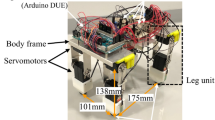Abstract
This paper describes a technique for statically stable gait synthesis for a quadruped robot using a simple Feed Forward Neural Networks (FFNN). A common approach for gait synthesis based on neural networks, is to use an implementation with Continuous Time Recurrent Neural Network (CTRNN) of arbitrary complex architecture as pattern generator for rhythmic limb motion. The preferred training method is implemented using genetic algorithms (GAs). However, to achieve the desired trajectory becomes an obstacle during the training process. This paper presents a much more simpler process converting a statically stable gait into actuator’s space via inverse kinematics; the training of the network is done with those references. By doing so, the training problem becomes a spatio-temporal machine learning problem. It is described a solution for trajectory generation combining a simple oscillator model with a Multilayer Feedforward Neural Network (MFNN) to generate the desired trajectory.
Preview
Unable to display preview. Download preview PDF.
Similar content being viewed by others
References
Amari, S.: Characteristic of the Random Nets of Analog Neuron-like Elements IEEE trans. on System. Man and Cybernetics SMC-2, 643–657 (1972)
Buchli, J., Ijspeert, A.J.: Distributed Central Pattern Generator Model for Robotics Application Based on Phase Sensitivity Analysis. In: Proc. of 1st. Intl. Workshop Bio-ADIT (2004)
Chiel, H.J., Beer, R.D., Gallagher, J.C.: Evolution and Analysis of Model CPGs for Walking: I. Dynamical Modules Journal of Computational Neuroscience 7, 99–118 (1999)
Chiel, H.J., Beer, R.D.: Evolution and Analysis of Model CPGs for Walking: II. General Principles and Individual Variability Journal of Computational Neuroscience 7, 99–118 (1999)
Molter, C.: Chaos in small Recurrent Neural Networks: theoretical and practical studies Spec. Report, Univ. Libre de Bruxelles (2004)
Gerstner, Kistler: Spiking Neuron Models. In: Single Neurons, Populations, Plasticity, Cambridge University Press, Cambridge (2002)
Fukuoka, Y., Kimura, H., Cohen, A.H.: Adaptive Dynamic Walking of a Quadruped Robot on Irregular Terrain Based on Biological Concepts. Int. Journ. of Robot. Res. 22(3–4), 187–202 (2003)
Kimura, H., Fukuoka, Y., Hada, Y., Takase, K.: Three-Dimensional Adaptive Dynamic Walking of a Quadruped - Rolling Motion Feedback to CPGs Controlling Pitching Motion. In: Proc. of ICRA 2002., pp. 2228–2233 (2002)
Lewis, M.A., Fagg, A., Bekey, G.: Genetic Algorithms for Gait Synthesis in a Hexapod Robot Recent Trends in Mobile Robots, pp. 317–331. World Scientific, New Jersey (1994)
Nishii, J., Susuki, R.: Oscillatory network model which learns a rhytmic pattern of an external signal. In: Proc. of IFAC Symposium, pp. 501–502 (1994)
Todd, D.J.: Walking Machines. In: An Introduction To Legged Robotics, Kogan Page Ltd. (1985)
Tsung, F.-S.: Modeling Dynamical Systems with Recurrent Neural Networks PhD Dissertation. Univ. of California, San Diego (1994)
Guan, X., Zheng, H., Zhang, X.: Biologically Inspired Quadruped Robot BIOSBOT: Modeling, Simulation and Experiment. In: 2nd Intl. Conf. on Autonomous Robots and Agents, New Zealand (2004)
Author information
Authors and Affiliations
Editor information
Editors and Affiliations
Rights and permissions
Copyright information
© 2006 Springer-Verlag Berlin Heidelberg
About this paper
Cite this paper
Cappelletto, J. et al. (2006). Gait Synthesis and Modulation for Quadruped Robot Locomotion Using a Simple Feed-Forward Network. In: Rutkowski, L., Tadeusiewicz, R., Zadeh, L.A., Żurada, J.M. (eds) Artificial Intelligence and Soft Computing – ICAISC 2006. ICAISC 2006. Lecture Notes in Computer Science(), vol 4029. Springer, Berlin, Heidelberg. https://doi.org/10.1007/11785231_76
Download citation
DOI: https://doi.org/10.1007/11785231_76
Publisher Name: Springer, Berlin, Heidelberg
Print ISBN: 978-3-540-35748-3
Online ISBN: 978-3-540-35750-6
eBook Packages: Computer ScienceComputer Science (R0)




